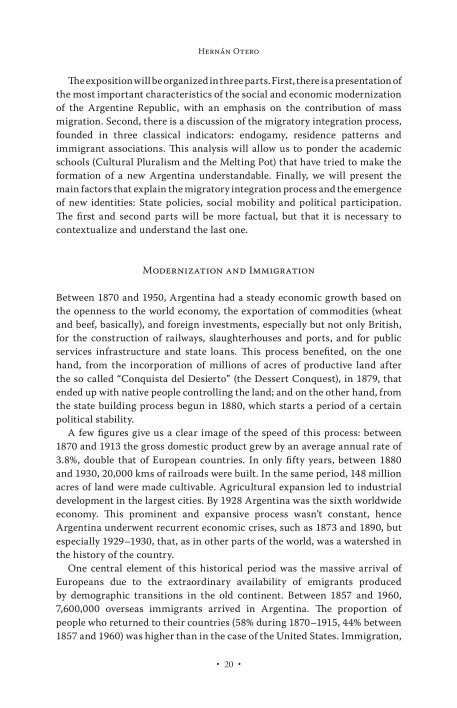

OCR
HERNÁN OTERO Theexpositionwillbeorganizedinthreeparts.First,thereisapresentation of the most important characteristics ofthe social and economic modernization of the Argentine Republic, with an emphasis on the contribution of mass migration. Second, there is a discussion of the migratory integration process, founded in three classical indicators: endogamy, residence patterns and immigrant associations. This analysis will allow us to ponder the academic schools (Cultural Pluralism and the Melting Pot) that have tried to make the formation of a new Argentina understandable. Finally, we will present the main factors that explain the migratory integration process and the emergence of new identities: State policies, social mobility and political participation. The first and second parts will be more factual, but that it is necessary to contextualize and understand the last one. MODERNIZATION AND IMMIGRATION Between 1870 and 1950, Argentina had a steady economic growth based on the openness to the world economy, the exportation of commodities (wheat and beef, basically), and foreign investments, especially but not only British, for the construction of railways, slaughterhouses and ports, and for public services infrastructure and state loans. This process benefited, on the one hand, from the incorporation of millions of acres of productive land after the so called “Conquista del Desierto” (the Dessert Conquest), in 1879, that ended up with native people controlling the land; and on the other hand, from the state building process begun in 1880, which starts a period of a certain political stability. A few figures give us a clear image of the speed of this process: between 1870 and 1913 the gross domestic product grew by an average annual rate of 3.8%, double that of European countries. In only fifty years, between 1880 and 1930, 20,000 kms of railroads were built. In the same period, 148 million acres of land were made cultivable. Agricultural expansion led to industrial development in the largest cities. By 1928 Argentina was the sixth worldwide economy. This prominent and expansive process wasn’t constant, hence Argentina underwent recurrent economic crises, such as 1873 and 1890, but especially 1929-1930, that, as in other parts of the world, was a watershed in the history ofthe country. One central element of this historical period was the massive arrival of Europeans due to the extraordinary availability of emigrants produced by demographic transitions in the old continent. Between 1857 and 1960, 7,600,000 overseas immigrants arrived in Argentina. The proportion of people who returned to their countries (58% during 1870-1915, 44% between 1857 and 1960) was higher than in the case ofthe United States. Immigration, * 20 +
Szerkezeti
Custom
Image Metadata
- Kép szélessége
- 1830 px
- Kép magassága
- 2834 px
- Képfelbontás
- 300 px/inch
- Kép eredeti mérete
- 1.17 MB
- Permalinkből jpg
- 022_000037/0020.jpg
- Permalinkből OCR
- 022_000037/0020.ocr
Bejelentkezés
Magyarhu
